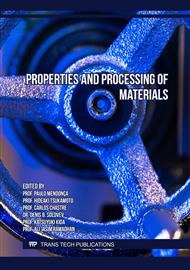[1]
N.A. Makhutov, K.V. Frolov, M.M. Gadenin and others, Scientific basis for increasing low-cycle strength, ed. N.A. Makhutova, Moscow: Nauka, 2006, p.623.
Google Scholar
[2]
N.I. Chernyak, Mechanical properties of steel in the area of small plastic deformations, Kiev, Academy of Sciences of the Ukrainian SSR, 1962, p.104.
Google Scholar
[3]
G.T. Kazanov, V.V. Novikov, G.P. Turmov, Stress concentration and other features of the stress state of vessel hull structures, Vladivostok: FEFU, 2014, p.178.
Google Scholar
[4]
DNV GL CG-0129-2015 Fatigue assessment of ship structures, Edition October 2015, p.236.
Google Scholar
[5]
R.I. Stephens, A. Fatemi, R.R. Stephens, H.O. Fuchs, Metal fatigue in engineering, John Wiley&Sons, 2001, p.452.
Google Scholar
[6]
F.C. Campbell, Fatigue and Fracture: Understanding the Basics. ASM International, 2012, p.525.
Google Scholar
[7]
J.A.F.O. Correia, A.M.P. de Jesus, A.A. Fernandes, R. Calçada, Mechanical Fatigue of Metals: Experimental and Simulation Perspectives, Structural Integrity 07 (Springer) 386 (2019).
DOI: 10.1007/978-3-030-13980-3
Google Scholar
[8]
G.V. Matokhin, A.V. Gridasov, Designing welded structures, Vladivostok: FESTU, 2007, p.169.
Google Scholar
[9]
A.I. Maksimadzhi, Strength of sea transport vessels, Increased strength steel application issues Leningrad, Shipbuilding, 1976, p.312.
Google Scholar
[10]
W.H. Munse, Fatigue of welded steel structures, Edited by La Motte Grover, New York: Welding Research Council, 1964, p.225.
Google Scholar
[11]
N.V. Oleinik, Endurance of machine parts, Kiev, Technics, 1979, p.200.
Google Scholar
[12]
G.V. Matokhin, K.P. Gorbachev, To an engeneer about thematerial destruction resistance, Monograph, Vladivostok: Dalnauka, 2010, p.281.
Google Scholar
[13]
A.V. Zheldubovsky, A.D. Pogrebnyak, M.N. Regulsky, A.T. Serditov, Yu.V. Klyuchnikov, P.V. Kondrashev, Assessment of the safety factor of machine parts subject to asymmetric loading, Eastern European Journal of Advanced Technologies. 6/7(66) (2013) 8-12.
Google Scholar
[14]
K.A. Molokov, Calculation of the resource of ferrite-pearlitic steels and the Goodman's diagram under different bases, In the compilation research on improving the efficiency of shipbuilding and ship repair, Issue 47, Vladivostok: FESTU, 2009, pp.194-201.
Google Scholar
[15]
K.A. Molokov, Evaluation of the endurance of welded joints taking into account the general plastic deformation of the material in a plane stressed state, FEFU school of engineering bulletin. 1(38) (2019) 19-26.
Google Scholar
[16]
S.S. Manson, G.L. Halford, Fatigue and durability of structural material, ASM International, 2006, p.456.
Google Scholar
[17]
D. Broek, The Practical Use of Fracture Mechanics, Kluwer Academic Publishers, 1988, p.532.
Google Scholar
[18]
Schijve Jaap, Fatigue of structures and materials, 2nd Ed. Springer, 2009, p.621.
Google Scholar
[19]
K.A. Molokov, A.V. Slavgorodskaya, Assessment of damage to ferrite-pearlitic steels during overloads, Marine Intellectual Technologies. 2 (2013) 56-58.
Google Scholar
[20]
V.Yu. Goltsev, A.V. Zelensky, O.G. Kudryavtsev, Yu.G.Matvienko, Zones of localization of plastic deformation in pre-deformed thin-sheet plastic materials, Investigation of the strength of materials and structures of nuclear technology, Moscow, Energoatomizdat, 1984, pp.68-73.
Google Scholar
[21]
B.Z. Margolin, V.A. Shevtsova, Analysis of the initiation and development of fatigue fracture in pearlitic steels, Problems of strength. 4 (1990) 12-21.
Google Scholar
[22]
K.A. Molokov, Assessment of damage to ferrite-pearlitic steels under low-cycle loading conditions, Proceedings of the conference "Science. Innovation. Engineering and Technology: Problems, Achievements and Prospects", Komsomolsk-on-Amur, FSFEI HPE, "KnAGU", 2015, pp.126-129 https://www.elibrary.ru/item.asp?id=25725387.
Google Scholar
[23]
G.V. Matokhin, Resource assessment of welded structures made of ferrite-pearlitic steels: Monograph, Vladivostok, FESTU (2001) 202.
Google Scholar


